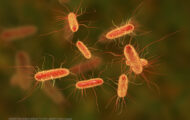According to the Morbidity and Mortality Report of the week of April 20, 2018, the long outbreak of Salmonella Newport infections that were linked to ground beef in 2016 and 2017 may have come from dairy cows. In that outbreak, 106 people in 21 states were sickened; 42 people were hospitalized, and one death occurred. This outbreak was not announced to the public at the time.

No direct link was found, but whole genome sequencing (WGS) of patient and sample isolates suggests that dairy cows were the “ultimate outbreak source.” The report states that foodborne illness outbreak investigations could be enhanced by improvements in traceability of cows from their originating farms, through slaughter and processing establishments, to the ground beef that is sold to consumers.
The outbreak began on October 4, 2016, and ran through July 19, 2017. The patients ranged in age from less than 1 year to 88 years old. Ground beef was identified as a common exposure among the patients. About the 65 interviewed, 52, or 80%, said they ate ground beef at home the week before they got sick. That was significantly higher than the FoodNet Population Survey, in which 40% of healthy people said they ate ground beef at home the week before they were interviewed. The patients bought ground beef from 15 grocery store chains, which were not identified.
Traceback was conducted, and approximately 20 ground beef suppliers belonging to at least 10 corporations were identified. Ten of the 11 records traced back to five company A slaughter/processing establishments, seven of 11 traced back to five company B slaughter/processing establishments, and four of 11 traced back to two company C slaughter/processing establishments.
Opened, leftover samples of ground beef from three patients; homes were collected for testing. All were purchased from one of two national grocery chains that were identified by most of the patients. One sample yielded the outbreak strain of Salmonella Newport.
The outbreak strain was also isolated from four New Mexico dairy cattle. The report states, ” Because of confidentiality practices, officials were not able to identify the farm or farms of origin for the dairy cows associated with the other three samples or whether the four dairy cows were associated with a single farm.”
Whole genome high-quality single nucleotide polymorphism (SNP) analysis sold that the 106 clinical isolates were closely related to each other genetically, to the four dairy cattle isolates, and to the leftover ground beef isolate. That means the illnesses most likely came from the same source.
Studies have shown that there is long-term persistence of Salmonella Newport in dairy herds. A 1987 Salmonella Newport outbreak was linked to contaminated ground beef from slaughtered dairy cows.
Investigators think that dairy cows that carry a high Salmonella load that overwhelm antimicrobial interventions could have gone to multiple slaughter establishments. That could contaminate multiple brands and lots of ground beef that are then sold around the country.
The distribution of illnesses in the southwest United States, and the fact that investigators identified the outbreak strain only in samples from dairy cattle in New Mexico indicates that there is a connection. Because product traceback didn’t find a single contaminated lot, and investigators weren’t able to find a connection between the slaughter house and the farms with the dairy cows that had the outbreak strain, a link couldn’t be established. Finally, cows aren’t tracked from farm to slaughter houses.
This outbreak was not announced to the public because officials couldn’t find a link between the outbreak and any products, grocery stores, restaurants, or establishments, so they couldn’t tell the public what to avoid. The report recommends four ways to stop foodborne illness from contaminated ground beef. The first three are recommended controls from the farm to slaughter houses, including good practice management for farms, and maintaining HACCP systems in slaughter houses.
Consumers only have control over the fourth point: to cook ground beef to 160°F every time, and measure the temperature with a reliable and accurate food thermometer. And, avoid cross-contamination by handling ground beef as if it is contaminated. Wash your hands, utensils, and surfaces often when working with raw ground beef.




